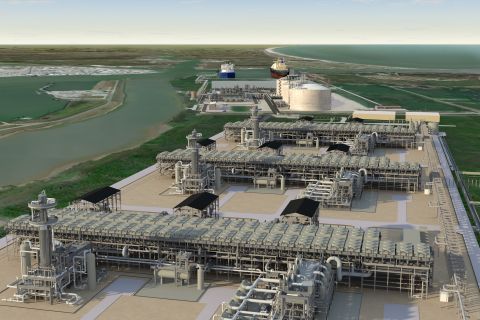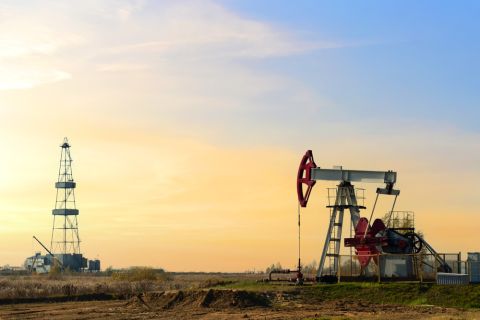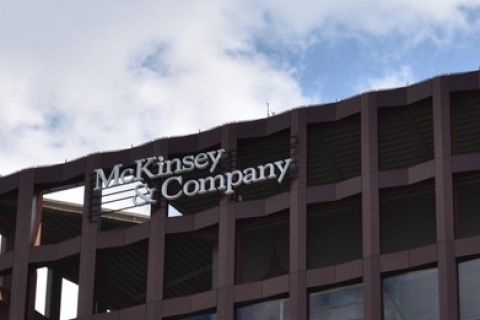No one is more enthusiastic about the outlook for oil and gas in the deepwater Gulf of Mexico (GoM) than Ernie Leyendecker, Anadarko’s vice president of exploration. And why not? His last five wells in the province have all hit pay dirt – and at least one of them, Shenandoah, is potentially huge.
The oil industry has “been in the Gulf of Mexico for over 65 years, and I never would have dreamed what we have learned over the last 12 months about how big things still could be,” Leyendecker said. He is not alone in believing the best could be yet to come.
The biggest companies agree. ExxonMobil will invest US $5 billion over the next three years in the deepwater GoM, according to Clay Vaughn, deepwater projects vice president for the US major.
Fellow major Chevron is spending $16 billion on new projects, added Steve Thurston, the company’s vice president of deepwater exploration and projects. “Technology advances have enabled the industry to safely explore for and produce oil and gas in subsurface formations and water depths we could only dream about 30 years ago,” he told E&P.
With five big production platforms scheduled for startup in 2014, the rig count rising, and discoveries piling up, oil and gas activity in the deepwater GoM appears headed for a banner year, accelerating away from the 2010 Macondo oil spill slowdown toward a new production peak by 2020.
GoM output at 2 MMb/d by 2020
“There is more exploration and development drilling activity now than before Macondo, and I expect that trend to continue upwards,” said Tommy Beaudreau, acting assistant interior secretary for land and minerals management and director of the Bureau of Ocean Energy Management (BOEM).
As a result, Wood Mackenzie forecast that GoM production will approach 2 MMb/d by 2020, up from the trough of 1.3 MMb/d in 2012 after Macondo and well above the previous record of 1.8 MMb/d set in 2009.
The evidence is there in the form of a new parade of giant production facilities beginning to flow from yards like Kiewit Offshore Services and Gulf Island Fabricators near Corpus Christi, Texas.
Next year is “really a huge year for new project startups,” said Wood Mackenzie analyst Jackson Sandeen, who specializes in the deepwater GoM. He cited Chevron’s Jack-St. Malo, Anadarko’s Lucius, Chevron’s Big Foot, and Hess’ Tubular Bells, all set for startup in 2014.
Add to that list Shell’s Olympus, which recently moved from Kiewit Ingleside to its operating location near the existing Mars production facility and is set for startup in 2014. Also coming are Hess’ Dalmatian subsea tieback to Petronius and Shell’s Cardamom Deep, which will produce through Auger.
The list of discoveries is growing across a broad area of the central GoM’s deepwater province, with Anadarko’s Phobos and Raptor, Shell’s Yucatan and Vicksburg A to the east, Chevron’s Coronado, and Cobalt’s North Platte all announced since December 2012.
Developments lining up
On the development side the calendar for targeted startups is filling up several years out. In 2015 LLOG’s Delta House and Noble’s Gunflint are on tap, followed by ExxonMobil’s Julia, Shell’s Stones, and Anadarko’s Heidelberg in 2016 and Shenandoah in 2017.
Stones and Julia are two more potentially huge finds with multibillion-barrel potential. “Development of the Julia field is already under way. Project front end engineering design [FEED] has been completed, and the engineering, procurement, and construction contracts have been placed,” Vaughn said.
Pipelines are reaching farther and farther out, with midstream companies such as Enterprise Partners, Enbridge, and Williams helping to provide export lines from isolated parts of the GoM such as Lucius, Jack-St. Malo, and Big Foot and from less isolated locations such as Tubular Bells.
And where pipelines don’t reach, more FPSO capacity is coming. Shell has announced that Stones – where development drilling is well under way – will be the GoM’s second FPSO project after Petrobras’ producing Cascade-Chinook project.
One sign that the good times are rolling is that prominent private equity funds have jumped in to commit billions of dollars to the deepwater GoM. LLOG’s teaming with Blackstone, which is putting $1.2 billion toward a long-term strategic GoM partnership, is the most prominent example.
$1 billion invested in safety and environment
There appears to be little concern that recent eye-catching problems in shallow water – including three loss-of-control incidents since February and a platform fire at gas wells on the shallow continental shelf – will affect deepwater progress. “We see development still moving forward,” said Wood Mackenzie’s lead deepwater GoM analyst Nimmi Henderson.
“It’s unfortunate,” Leyendecker said of the incidents. “I don’t think it’ll have a direct bearing on what’s going on in deep water. We have invested over $1 billion as an industry in safety and environmental management systems since the events of 2010.”
After meeting with company executives to discuss the incidents, Beaudreau said he expects no major changes in regulatory approach. “The incident doesn’t change anything in terms of our overall approach to safety and oversight, which is that safety remains our top priority,” he said.
Technology challenges to be tackled
Technological challenges remain. High pressures and high temperatures in the deepest discoveries are pushing the 15,000-psi, 121°C (250°F) limits of current capability, and that will affect the pace of development, Cobalt CEO Joe Bryant said during a second-quarter earnings call. “We are well into conversations with equipment suppliers to … push that 15,000-psi limit higher, whether it’s 17,500 psi or 20,000 psi,” Bryant said. “It’s not one that scares us in the sense that it can’t be solved, but it is going to be a factor in how we develop these.”
Leyendecker said equipment that can withstand 20,000 psi and 149°C (300°F) is needed.
Production from Lower Tertiary reservoirs is uneven and tempers expectations despite the encouraging new finds. Some discoveries like Shenandoah are highly permeable and porous and contain relatively low-viscosity oil. Other Lower Tertiary discoveries are proving more challenging to produce. But the industry has a history of overcoming such technological challenges, and the future will be no different, predicted Thurston.
“Technology plays a key role in the development of Julia,” Vaughn said. “For example, the subsea pumps on the project will be one of the deepest applications and [have the] highest design pressure in the industry to date.”
Good geology
Leyendecker said advances in seismic survey capability and rig design are key to pushing into deeper water and deeper under the seabed. “The seismic industry continues to make incremental improvements in acquisition techniques and processing algorithms, so we continue to get a little bit better image of our targets year after year,” Leyendecker said. “Not that they’re easy targets.”
The knowledge and judgment to use seismic effectively are growing. “I try to tell people what we will drill is good geology, not good seismic images,” he said, citing mature source rock, good reservoir sands, and an identifiable trap as evaluations that require experience and skills beyond seismic data.
Improved rig capability – drawworks that can handle 2.5 MMlb of drillstring, that have the capability to do two drilling tasks simultaneously, and that are equipped with dual BOPs – is another major factor. “Now we can drill wells to 9,144-plus m [30,000-plus ft] and we can run very, very deep strings of casing that are very, very heavy, all at one time,” Leyendecker said.
Rig activity
The data on current and forecast future deepwater rig activity are impressive. As of mid-July 2013 there were 42 rigs under contract in the deepwater GoM, according to the RigLogix database. That’s up from 35 immediately before the Macondo disaster. There were 42 rigs in the GoM in August 2010, but only two were working due to the post-Macondo drilling moratorium.
More rigs with more capability also are coming. RigLogix counted three newbuild semisubmersibles and 13 newbuild drillships expected to begin work in the GoM in 2014 and two more newbuild drillships in 2015. And of the five rigs that left the GoM during the moratorium, two have returned.
The 2013 count of drilling permits granted by the government is a bit behind 2012 as of mid-year. Permits surged in 2012 as the regulatory process recovered from Macondo. Companies have said regulators have struggled to keep up with surging demand.
But the agenda already includes billions of dollars of approved work. “When you see that kind of investment not only in the front-end exploration activity but in the longer term infrastructure development to bring production online, you can tell folks are looking not one year out, but five, 10, 15, [and] 20 years out,” Beaudreau said.
GOM DEEPWATER PROJECTS LINEUP
Fast facts detail current and future projects and the latest discoveries in the region.
2013 To 2014 New Projects
Olympus. Startup in 1Q 2014. Tension-leg platform (TLP). Design capacity of 100,000 b/d. Estimated reserves: Will increase Mars lifetime output by 400 MMbbl. Located in 914 m (3,000 ft) of water. Located in Mississippi Canyon Block 807, 209 km (130 miles) south of New Orleans. No cost estimate disclosed. Owned by operator Shell (71.5%) and BP (28.5%). Of interest: Second TLP in Mars field. Will add six-well West Boreas/South Deimos subsea developments. Mars discovered in 1989, and Shell predicted 700 MMbbl of resources. To date has produced 770 MMbbl. Olympus will enable output to reach estimated 1.1 Bbbl through 2050. Adds oil and gas export system to West Delta 143-C, a new shallow-water platform.
Jack-St. Malo. Startup in 4Q 2014. Floating production unit. Design capacity of 170,000 b/d and 1.2 MMcm/d (42.5 MMcf/d). Estimated reserves of 500 MMbbl. Loated in 2,134 m (7,000 ft) of water. Located in Walker Ridge Block 718, 450 km (230 miles) south of New Orleans. Total cost is $7.5 billion. Owned by operator Chevron (51%), Petrobras (25%), Statoil (21.5%), ExxonMobil (1.25%), and Eni (1.25%). Of interest: Early Lower Tertiary discovery in 2003, strong flow tests. Jack drilled to 8,593 m (28,175 ft) true vertical depth (TVD).
Lucius. Startup in the second half of 2014. Spar. Design capacity of 80,000 b/d and 12.7 MMcm/d (450 MMcf/d). Estimated reserves of 300 MMbbl. Located in 2,164 m (7,100 ft) of water in Keathley Canyon Block 875, 462 km (287 miles) south-southwest of New Orleans. Cost is $2.8 billion. Owned by operator Anadarko (27.8%), Freeport-McMoran (23.3%), Apache (11.7%), ExxonMobil (15%), Petrobras (9.6%), INPEX (7.2%), and Eni (5.4%). Of interest: Major infrastructure addition involves 161 km (100 miles) of new 18-in. oil export pipeline plus reuse of 80-km (50-mile) existing line; also involves 370 km (230 miles) of a new 20-in. gas export line. During 2Q 2013, another well in the field hit 183 net m (600 net ft) of oil play in the Pliocene with sands full to base.
Big Foot. Startup is in 2014. Extended TLP. Design capacity of 75,000 b/d and 708 Mcm/d (25 MMcf/d). Estimated reserves of 200 MMbbl. Located in 1,600 m (5,200 ft) of water in Walker Ridge Block 29, 360 km (225 miles) south of New Orleans. Cost is $4 billion. Owned by operator Chevron (60%), Statoil (27.5%), and Marubeni (12.5%). Of interest: It is a dry tree extended TLP with an onboard drilling rig. Net oil pay of 91 m (300 ft) at TVD of more than 7,600 m (25,000 ft).
Tubular Bells. Startup is in 2Q 2014. Spar. Design capacity of 60,000 b/d and 5.7 MMcm/d (200 MMcf/d). Estimated reserves of 125 MMboe. Located in 1,311 m (4,300 ft) of water in Mississippi Canyon Block 726, about 217 km (135 miles) southeast of New Orleans. Cost $2.3 billion. Owned by Hess (operator) 57.14% and Chevron 42.86%. Of interest: Subsea project will deliver 40,000 b/d to 45,000 b/d through a tieback to Gulfstar-built spar, which also will serve other third parties.
2012 To 2013 Discoveries
Shenandoah-2. Has 305 m (1,000 ft) of net oil pay at TVD 9,572 m (31,405 ft) in 1,768 m (5,800 ft) of water in Walker Ridge Block 52. Owned by operator Anadarko (30%), ConocoPhillips (30%), Cobalt (20%), Marathon (10%), and Venari (10%).
Phobos. Has 76 m (250 ft) of net oil pay at TVD 8,740 m (28,675 ft) in 2,591m (8,500 ft) of water in Sigsbee Escarpment 39. Owned by operator Anadarko (30%), Plains (50%,) and ExxonMobil (20%). Raptor. Has 46 m (150 ft) of net oil pay at TVD 6,747 m (22,135 ft) in 2,499 m (8,200 ft) of water in Desoto Canyon 535. Of interest: Jurassic discovery. Owned by operator Anadarko and BHP, each with a 50% interest.
Yucatan. Has 37 m (120 ft) of net oil pay at TVD 9,830 m (32,250 ft) in 1,768 m (5,800 ft) of water in Walker Ridge Block 95. Of interest: near Shenandoah-2 but syncline-separated from it. Owned by operator Shell (70%), Anadarko (15%), and INPEX (15%).
North Platte. Has 168 m (550 ft) of net pay at TVD 10,516 m (34,500 ft) in 1,341 m (4,400 ft) of water in Garden Banks 959. Owned by operator Cobalt (60%) and Total (40%).
Coronado. Has 122 m (400 ft) of net pay at TVD 9,713 m (31,866 ft) in 1,868 m (6,127 ft) of water in Walker Ridge Block 98. Owned by operator Chevron (40%), ConocoPhillips (35%), Anadarko (15%), and Venari (10%). Of interest: near Shenandoah, successful sidetrack in 2Q 2013.
Future Projects
Mad Dog II. Delayed for reevaluation but expected eventually to go forward. FEED began in 2012. A final investment decision is targeted for 2014. The plan called for a second spar at the Mad Dog field, with 19 producing and 14 water injection wells and incremental production of up to 140,000 boe/d. In Green Canyon Block 782. Owned by operator BP (60.5%), BHP (23.9%), and Chevron (15.6%).
Stampede (originally Pony and Knotty Head). Expected to enter FEED this year. Field in Green Canyon blocks 468, 511, and 512 in 1,097 m (3,600 ft) of water. Reservoir depth is 9,144 m (30,000 ft). Owned by operator Hess, Chevron, Union, Statoil, and BHP, all with 20% each.
Stones. Targeted startup in 2016. FPSO. Eight blocks centered around Walker Ridge Block 508 in 2,896 m (9,502 ft) of water about 300 km (186 miles) southwest of New Orleans. Has potential reserves of 2 Bbbl. No cost estimate disclosed. Of interest: Gulf of Mexico’s second FPSO vessel in what will be the world’s deepest water production facility. Production capacity of 50,000 b/d. Owned by operator Shell (60%), Petrobras (25%), and Eni (15%).
Julia. Targeted startup in 2016. Subsea tieback to Jack-St. Malo. Five blocks centered around Walker Ridge Block 627 in 2,200 m (7,218 ft) of water about 350 km (217 miles) southwest of New Orleans. Potential reserves of 6 Bbbl. Cost estimate of $4 billion. Owned by operator ExxonMobil and Statoil, each of which holds a 50% stake. Of interest: Capacity of 34,000 b/d flow to Jack-St. Malo.
Heidelberg. Targeted startup in 2016. Spar. Green Canyon blocks 850, 859, 903, 904, and 948 in 1,615 m (5,300 ft) of water. Potential reserves of 400 MMbbl. Owned by operator Anadarko (31.5%), Marubeni (12.5%), Eni (12.5%), Apache (12.5%), Statoil (12%), ExxonMobil (9.375%), and Cobalt (9.375%). Of interest: Spar capacity of 80,000 b/d.
Gunflint. Targeted startup in 2015. Tieback, but not yet specified where. Mississippi Canyon Block 948 in 1,860 m (6,103 ft) of water 250 km (155 miles) southeast of New Orleans. Owned by operator Noble (31.14%), Ecopetrol (31.5%), Samson (19.12%), and Marathon (18.23%). Of interest: an appraisal well hit 33 m (108 ft) of net pay but found nothing in the lower zone. An initial estimate of potential 500 MMbbl of reserves currently estimated at 65 MMbbl to 90 MMbbl, but Noble planning further exploration of structure to the north.
Recommended Reading
Segrist: The LNG Pause and a Big, Dumb Question
2024-04-25 - In trying to understand the White House’s decision to pause LNG export permits and wondering if it’s just a red herring, one big, dumb question must be asked.
The Secret to Record US Oil Output? Drilling Efficiencies—EIA
2024-03-06 - Advances in horizontal drilling and fracking technologies are yielding more efficient oil wells in the U.S. even as the rig count plummets, the Energy Information Administration reported.
McKinsey: US Output Hinges on E&P Capital Discipline, Permian Well Trends
2024-02-07 - U.S. oil production reached record levels to close out 2023. But the future of U.S. output hinges on E&P capital discipline and well-productivity trends in the Permian Basin, according to McKinsey & Co.
Exxon, Vitol Execs: Marrying Upstream Assets with Global Trading Prowess
2024-03-24 - Global commodities trading house Vitol likes exposure to the U.S. upstream space—while supermajor producer Exxon Mobil is digging deeper into its trading business, executives said at CERAWeek by S&P Global.
Paisie: Dutch Vehicle Fleet Foreshadows Structural Shifts
2024-03-26 - The expanding role of battery electric vehicles will be supported by the development of associated supply chains, as indicated by Stratas Advisors' forecast of global EV battery production capacity.





